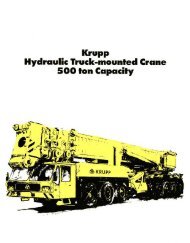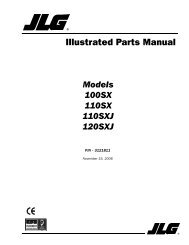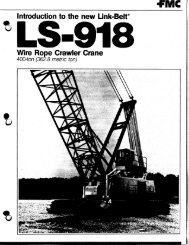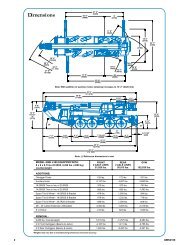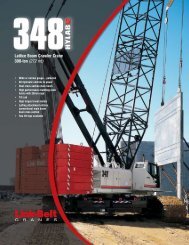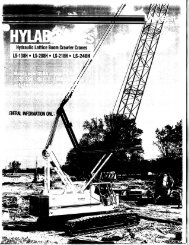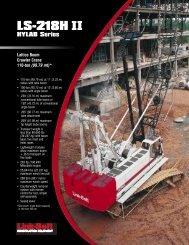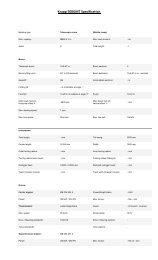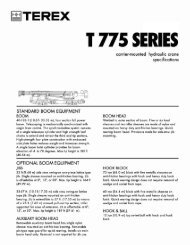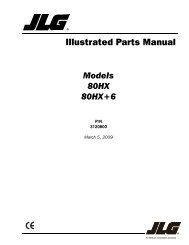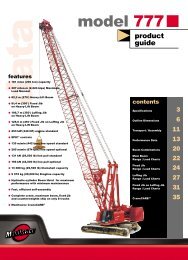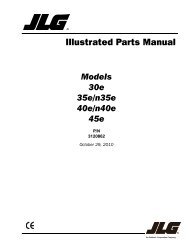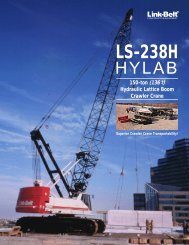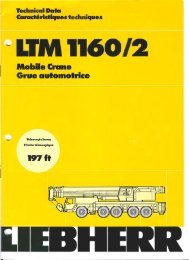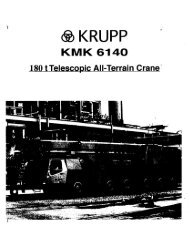Linkbelt-LS208H2-Spec - Rawalwasia
Linkbelt-LS208H2-Spec - Rawalwasia
Linkbelt-LS208H2-Spec - Rawalwasia
You also want an ePaper? Increase the reach of your titles
YUMPU automatically turns print PDFs into web optimized ePapers that Google loves.
OPERATING INSTRUCTIONS<br />
GENERAL:<br />
1. Rated lifting capacities in pounds as shown on lift<br />
charts pertain to this crane as originally manufactured<br />
and normally equipped. Modifications to the crane or<br />
use of optional equipment other than that specified can<br />
result in a reduction of capacity.<br />
2. Construction equipment can be dangerous if<br />
improperly operated or maintained. Operation and<br />
maintenance of this crane must be in compliance with<br />
the information in the Operator’s, Parts, and Safety<br />
Manuals supplied with this crane. If these manuals are<br />
missing, order replacements through the distributor.<br />
3. The operator and other personnel associated with this<br />
crane shall read and fully understand the latest<br />
applicable American National Standards Institute<br />
(ANSI) safety standards for cranes.<br />
4. All capacities listed in this book are in compliance with<br />
ASME/ANSI B30.5c–1998, SAE J987–April 1994, and<br />
SAE J765–October 1990.<br />
LIFT CRANE OPERATION:<br />
1. Capacities shown are in pounds and are not more than<br />
75% of the tipping loads with the crane standing level<br />
on firm supporting surface. A deduction must be made<br />
from these capacities for weight of hook block, hook<br />
ball, sling, grapple, etc. When using main hook while<br />
jib is attached, reduce capacities by values shown on<br />
Capacity Deductions For Lifting Off Main Boom Hook<br />
With Jib Installed. When using main hook while 5 foot<br />
tip extension is attached, reduce capacities by values<br />
shown on Capacity Deductions For Lifting Off Main<br />
Boom Hook With 5 foot Tip Extension Installed. See<br />
Operator’s Manual for all limitations when raising or<br />
lowering attachment.<br />
2. The crane capacities in the shaded areas are based on<br />
structural strength. The crane capacities in the<br />
non–shaded areas are based on stability.<br />
3. For recommended reeving, parts of line, wire rope<br />
type, and wire rope inspection, see Wire Rope<br />
Capacity chart, Operator’s Manual, and Parts Manual.<br />
Rated lifting capacities are based on correct reeving.<br />
Deduction must be made for excessive reeving. Any<br />
reeving over minimum required (see Wire Rope<br />
Capacity Chart) is considered excessive and must be<br />
accounted for when making lifts. Use working range<br />
diagram to estimate the extra feet of rope then deduct<br />
1.9 lb. for each extra foot of wire rope before<br />
attempting to lift a load.<br />
4. Load ratings in this Crane Rating Manual are based on<br />
freely suspended loads and make no allowances for<br />
such factors as the effect of the wind, ground<br />
conditions, and operating speeds. The operator shall<br />
therefore reduce load ratings in order to take these<br />
conditions into account.<br />
5. Rated lifting capacities do not account for the effects of<br />
wind on a suspended load or boom. Lifting capacities<br />
should be considered acceptable for wind speeds less<br />
than 20 mph and appropriately reduced for wind<br />
speeds greater than 20 mph. Extreme caution should<br />
be used when lifting heavy loads or loads with large<br />
wind sail area under high wind conditions (over 20<br />
mph).<br />
6. The capacities listed in this Crane Rating Manual are<br />
for the machine with or without live mast, with the<br />
gantry in the raised position.<br />
7. The least stable rated condition is over the side.<br />
8. Booms should be erected and lowered over the end for<br />
maximum stability. See liftoff capabilities before<br />
erecting or lowering boom.<br />
9. Do not operate at radii and boom lengths where the<br />
Crane Rating Manual lists no capacity. Do not use<br />
longer booms or jibs than those listed in this Crane<br />
Rating Manual. Any of the above can cause a tipping<br />
condition, or boom and jib failure.<br />
10. These capacities apply only to the crane as originally<br />
manufactured and normally equipped by Link–Belt<br />
Construction Equipment Company.<br />
FOR OVER END BLOCKED CAPACITIES ONLY<br />
1. These capacities can be lifted over either end with the<br />
crane standing level on a firm supporting surface with<br />
adequate blocking placed under the tread member<br />
sprockets/idlers, to prevent rocking.<br />
2. Do not travel with a load.<br />
TRAVELING WITH A LOAD:<br />
1. All 360 Rotation capacities listed in this Crane Rating<br />
Manual are pick and carry capacities.<br />
2. The boom must be pointing straight over one end of the<br />
crawler lower. If the load was lifted over the side, swing<br />
the load over the end and/or if the load was lifted at a<br />
long radius and the load is at or near capacity for that<br />
radius, boom up to obtain a greater lifting capacity<br />
before beginning travel.<br />
3. Engage the swing lock and apply swing brake.<br />
4. Travel slowly and cautiously on a firm and<br />
level–supporting surface.<br />
DEFINITIONS:<br />
1. Load Radius: Horizontal distance from a projection of<br />
the axis of rotation to the supporting surface, before<br />
loading, to the center of the vertical hoist line or tackle<br />
with load applied.<br />
LS–208H



